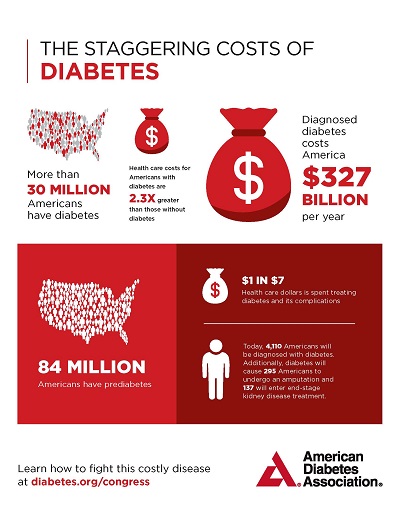

- Industry Highlights
-
by admin
The Cost of Diabetes

The American Diabetes Association (Association) released new research on March 22, 2018 estimating the total costs of diagnosed diabetes have risen to $327 billion in 2017 from $245 billion in 2012, when the cost was last examined.
This figure represents a 26 percent increase over a five-year period.
The study, Economic Costs of Diabetes in the U.S. in 2017, was commissioned by the Association and addresses the increased financial burden, health resources used and lost productivity associated with diabetes in 2017. The study includes a detailed breakdown of costs along gender, racial and ethnic lines, and also includes a breakdown of costs on a state-by-state basis.
Results
The total estimated cost of diagnosed diabetes in 2017 is $327 billion, including $237 billion in direct medical costs and $90 billion in reduced productivity.
The largest components of medical expenditures are:
- hospital inpatient care (30% of the total medical cost),
- prescription medications to treat complicationsharmful effects of diabetes such as damage to the eyes, heart, blood vessels, nervous system, teeth and gums, feet and skin, or kidneys. Studies show that keeping blood glucose, blood pressure and low-density lipoprotein cholesterol levels close to normal can help prevent or delay these problems.X of diabetes (30%),
- anti-diabetic agents and diabetes supplies (15%), and
- physician office visits (13%).
People with diagnosed diabetes incur average medical expenditures of $16,752 per year, of which about $9,601is attributed to diabetes. People with diagnosed diabetes, on average, have medical expenditures approximately 2.3 times higher than what expenditures would be in the absence of diabetes.
For the cost categories analyzed, care for people with diagnosed diabetes accounts for 1 in 4 health care dollars in the U.S., and more than half of that expenditure is directly attributable to diabetes.
Indirect costs include:
- increased absenteeism ($3.3 billion) and
- reduced productivity while at work ($26.9 billion) for the employed population,
- reduced productivity for those not in the labor force ($2.3 billion),
- inability to work as a result of disease-related disability ($37.5 billion), and
- lost productive capacity due to early mortality ($19.9 billion).
Diabetes Costs in Specific Populations
- Most of the cost for diabetes care in the U.S., 67.3%, is provided by government insurance (including Medicare, Medicaid, and the military). The rest is paid for by private insurance (30.7%) or by the uninsured (2%).
- People with diabetes who do not have health insurance have 60% fewer physician office visits and are prescribed 52% fewer medications than people with insurance coverage—but they also have 168% more emergency department visits than people who have insurance.
- Total per-capita health expenditures are higher among men than women ($10,060 vs. $9,110).
- Total per-capita health care expenditures are lower among Hispanics ($8,050) and higher among non-Hispanic blacks ($10,470) and among non-Hispanic whites ($9,800).
- Compared to non-Hispanic whites, per capita hospital inpatient costs are 23% higher among non-Hispanic blacks and 29% lower among Hispanics. Non-Hispanic blacks also have 65% more emergency department visits than the population with diabetes as a whole.
- Among states, California has the largest population with diabetes and thus the highest costs, at $39.47 billion. Texas ($25.60 billion), Florida ($24.80 billion), and New York ($21.23 billion) round out the top four states in terms of total annual cost.
Conclusions
The estimated total economic cost of diagnosed diabetes in 2017 is $327 billion, a 26% increase from our previous estimate of $245 billion (in 2012 dollars).
This estimate highlights the substantial burden that diabetes imposes on society. Additional components of societal burden omitted from our study include intangibles from pain and suffering, resources from care provided by non-paid caregivers, and the burden associated with undiagnosed diabetes.

